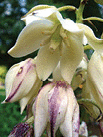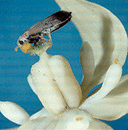

 Yucca is a perennial shrub or tree which grows largely in warm and dry areas of the Americas. Yucca is used for decorative planting and extracts from the yucca plant have medicinal uses. Yucca plants are able to survive in dry areas because their thick leaves store water and are covered with an oily or waxy substance which helps to prevent loss of moisture through evaporation. They also store water in their thick roots and the curved leaves of the yucca channel rainwater toward the roots.
Yucca is a perennial shrub or tree which grows largely in warm and dry areas of the Americas. Yucca is used for decorative planting and extracts from the yucca plant have medicinal uses. Yucca plants are able to survive in dry areas because their thick leaves store water and are covered with an oily or waxy substance which helps to prevent loss of moisture through evaporation. They also store water in their thick roots and the curved leaves of the yucca channel rainwater toward the roots.
 Yucca is also the name of a moth which has an exclusive symbiotic relationship with the plant. The female yucca moths are designed in such a way that they can transfer pollen from the stamens of one yucca plant to the stigma of another yucca plant and then lay an egg in the flower. As seeds develop, the moth larva hatches and feeds on some of the seeds. I say some of the seeds because it always leaves enough seeds so that
Yucca is also the name of a moth which has an exclusive symbiotic relationship with the plant. The female yucca moths are designed in such a way that they can transfer pollen from the stamens of one yucca plant to the stigma of another yucca plant and then lay an egg in the flower. As seeds develop, the moth larva hatches and feeds on some of the seeds. I say some of the seeds because it always leaves enough seeds so that  the yucca plant species can survive. The yucca plants are pollinated only by the yucca moth and the yucca moth larvae feed only on the yucca seeds. Without the yucca moth, the yucca plant could not survive. Without the yucca plant, the yucca moth could not survive. That relationship is called “symbiosis,” which is derived from two Greek words meaning “living together.” It is one more example of the wonderful design we see in the world around us and design demands a designer.
the yucca plant species can survive. The yucca plants are pollinated only by the yucca moth and the yucca moth larvae feed only on the yucca seeds. Without the yucca moth, the yucca plant could not survive. Without the yucca plant, the yucca moth could not survive. That relationship is called “symbiosis,” which is derived from two Greek words meaning “living together.” It is one more example of the wonderful design we see in the world around us and design demands a designer.
Picture credits:
© Roland Earnst
https://commons.wikimedia.org/wiki/File:Yucca-aloifolia-20071002-2.jpg
https://commons.wikimedia.org/wiki/File:Tegeticula.jpg
